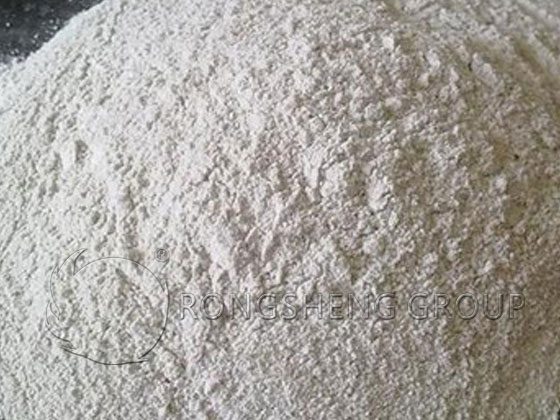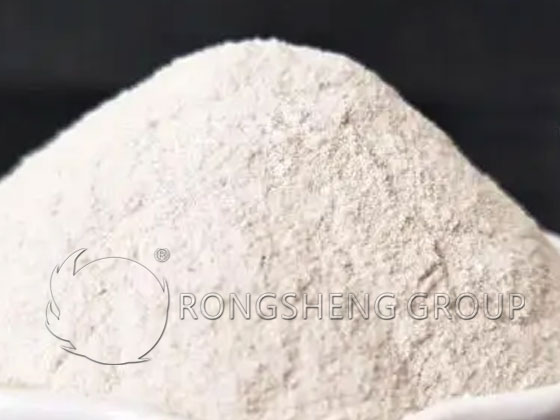Why is fluorspar used to smelt stainless steel? fluorite price per ton? The role of fluorspar in the field of steelmaking is to enhance the fluidity of molten steel. Otherwise, the molten steel will be like slurry and not easy to pour.
Fluorite is a flux, and its main component is CaF2. The melting point of pure CaF2 is 1418°C. Fluorite also contains components such as SiO2 and S, so the melting point is around 930°C. After being added into the furnace, the melting point of the high-melting-point 2CaO·SiO2 shell of CaO and lime is lowered to generate a low-melting-point compound 3CaO·CaF2·2SiO2 (melting point is 1362°C). It can also form low melting point compounds (1350°C) with MgO to improve the fluidity of slag. Fluorite has a fast fluxing effect and a short time. However, excessive use of fluorite will form severe foam residue and cause splashing. At the same time, it also intensifies the erosion of the furnace lining and pollutes the environment. Therefore, the amount of fluorspar added per ton of steel should be strictly controlled.

The fluorite used in the converter has wCaF2≥85%, wSiO2≤5.0%, wS≤0.10%, wP≤0.06%, the block size is 5~50mm, and it must be dry and clean.
In recent years, due to the insufficient supply of fluorspar, steel mills have tried a variety of fluorspar substitutes from the perspective of environmental protection, all of which are fluxes based on manganese oxide or iron oxide. Such as iron-manganese ore, iron oxide scale, converter soot, ferrous bauxite, etc.
Fluorite can be used as a Metallurgical Flux
Fluorite, also known as fluorspar, is a mineral whose main component is calcium fluoride (CaF2). Contains more impurities, and Ca is often replaced by rare earth elements such as Y and Ce. In addition, it also contains a small amount of Fe2O3 and is an important fluorine-containing industrial mineral. Humans have a long history of using fluorspar, and its use as a metallurgical flux was discovered in 1556.
Fluorite powder is a powdery material formed from fluorite after grinding, flotation, dehydration, and drying. It is widely used in the chemical industry, steelmaking, non-ferrous metallurgy, glass and ceramics, and other industries. After processing, it can also be used in high-precision fields such as military cables and optical fiber transmission. In industry, fluorite is the main source of fluorine and can be extracted and prepared to produce fluorine and its various compounds. It is also used as a flux in steelmaking to remove impurities and in the production of glass and enamel.
In addition, there is a large demand for fluorite in the optical field, and its artificial crystals can be made into a variety of lenses when grown. Fluorite has bright and rich colors and smooth crystals. However, due to its low hardness, it cannot usually be used as jewelry. But because fluorite is soft, when large enough crystals appear, it can be relatively easily used to carve decorations.
Fluorite powder used in the metallurgical industry contains halogen element F, which can lower the melting point of refractory substances, promote the flow of slag, and achieve good separation of slag and metal. It desulfurizes and dephosphorizes during the smelting process to enhance the forgeability and tensile strength of the metal. Therefore, it is widely used as a flux in steel smelting and ferroalloy production, petrochemical processes, and non-ferrous metal smelting. High-quality acid Chemicalbook grade fluorspar is also used in electric furnaces to produce high-quality special steel and special alloy steel. A small part is used as a casting agent in the steel foundry industry.

After the raw ore is crushed and ground, acidic fluorspar powder is recovered by flotation. fluorite price per ton. Fluorite powder for smelting generally requires the calcium fluoride content to be greater than 65%, and there are also certain requirements for the main impurity silica and strict restrictions on sulfur and phosphorus. Desulphurization during the smelting process. Fluorite powder cannot be put directly into the furnace because it is powder. Adding fluorspar powder to a metallurgical pellet binder through stirring and molding processes, processing it into pellets, and then applying it to smelting is the best way to replace lump ore with fluorspar powder.
In What Fields Can Fluorite Powder be Mainly Used?
Fluorite is naturally indispensable for the production of fluorite powder. Fluorite, also known as fluorspar, is a natural fossil. Compared with optical glass, fluorite has the advantages of low refractive index and low dispersion. However, in actual application, it is impossible to use it due to its difficulty and economic factors. However, the so-called optical glass used in optics uses silica as the main raw material. And add additives such as barium oxata or lanthanum, and dissolve it in a lanthanum furnace at a high temperature higher than 1300 degrees. Then it solidifies from liquid to solid by cooling.
- Metallurgical industry. Fluorite can lower the melting point of refractory substances, promote the flow of slag, and make the slag and metal well separated. During the smelting process, it desulfurizes and dephosphorizes, and enhances the forgeability and tensile strength of the metal. Therefore, it is widely used as a flux in steel smelting and ferroalloy production, petrochemical processes, and non-ferrous metal smelting. Fluorite ore used for smelting generally requires the calcium fluoride content to be greater than 65%, and there are also certain requirements for the main impurity silica and strict restrictions on sulfur and phosphorus. The content of sulfur and phosphorus shall not exceed 0.3% and 0.08% respectively.
- Chemical industry. The main raw material for the production of anhydrous hydrofluoric acid and the basic raw material for fluorine chemicals (Freon, fluoropolymers, fluorine-containing fine chemicals).
- Cement industry. Mineralizing agent for the production of cement clinker can reduce the sintering temperature, is easy to calcine, has a short firing time, and saves energy.
- Glass industry. Raw materials for the production of emulsified glass, opaque glass, and tinted glass. It can lower the temperature during glass melting, improve the melt, accelerate melting, and thus reduce the fuel consumption rate.
- Ceramic industry. Flux and opacifiers are used in the process of manufacturing ceramics and enamel, and they are also indispensable ingredients for preparing glaze.
Fluorite Powder Suppliers
Fluorite powder has many characteristics and is used in different fields. Fluorite powder commonly available on the market is in the form of yellow powder. It should be stored in a ventilated and dry place and protected from moisture. If you want to purchase and apply fluorite powder after learning about the functions of fluorite powder and get fluorite price per ton, you can contact us directly. We can provide fluorite powder with reliable product quality and competitive prices.
Leave Your Requirements on RS Kiln Refractory Bricks And Castable Materials! We Will Reply You In 12 Hours!: